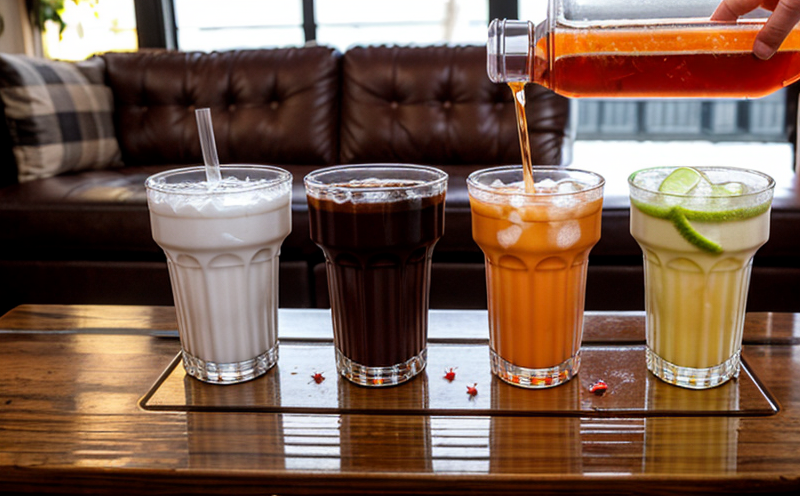AOAC 999.11 Heavy Metal Profiling in Beverages
The AOAC International Standard Method 999.11 is a widely recognized protocol for the determination of heavy metals in beverages, ensuring product safety and compliance with regulatory standards. This test method provides accurate quantification of heavy metal content such as lead (Pb), cadmium (Cd), mercury (Hg), and arsenic (As) in various beverage samples.
The process involves several critical steps to ensure the precision and reliability of results. Initially, the sample is prepared by dilution or digestion using appropriate chemical reagents followed by a thorough filtration step to remove particulates. The filtered solution undergoes instrumental analysis utilizing Inductively Coupled Plasma Mass Spectrometry (ICP-MS), which offers high sensitivity and selectivity necessary for detecting trace levels of heavy metals.
The results are reported in parts per billion (ppb) or micrograms per liter (µg/L). Compliance with international standards like ISO, ASTM, EN, and IEC is crucial as these benchmarks set the thresholds for acceptable concentrations of heavy metals. For instance, regulatory limits might specify maximum allowable levels of lead at 10 ppb in beverages intended for children.
This service plays a vital role in safeguarding public health by identifying potential contamination sources early on during production or sourcing stages. By adhering to stringent testing protocols, laboratories can help brands maintain their reputation and avoid costly recalls due to non-compliance issues.
| Sample Type | Acceptance Criteria | Limit of Detection (LOD) |
|---|---|---|
| Beverages including juices, teas, coffees, and alcoholic drinks | Average concentration should not exceed specified limits set by relevant regulations | For most metals, the LOD is around 0.1–1 ppb depending on matrix complexity |
| Specific tolerance levels for different beverages can vary based on intended use and age group consumption |
| Instrumentation Used | Calibration Standards |
|---|---|
| ICP-MS, ICP-AES (if required for specific elements) | Traceable to NIST or other recognized calibration materials |
| Quality control samples are run alongside test batches regularly |
The AOAC 999.11 method is essential for ensuring the safety of beverages, especially those consumed by vulnerable populations like infants and young children. Regular monitoring helps companies stay ahead of potential contamination risks, thereby fostering trust among consumers.
Our laboratory adheres strictly to this methodology, leveraging advanced technology and experienced personnel to deliver accurate results consistently. This ensures that our clients receive reliable data which they can use confidently in decision-making processes related to product safety and regulatory compliance.
Industry Applications
The AOAC 999.11 heavy metal profiling method has broad applications across the food & beverage industry, particularly relevant for manufacturers of juices, teas, coffee products, and alcoholic beverages. Here are some key areas where this testing protocol finds application:
- Ensuring compliance with local and international regulatory requirements regarding heavy metals in foodstuffs.
- Monitoring supply chain integrity by verifying the authenticity of raw materials used during processing.
- Investigating instances of product contamination to identify sources quickly and implement corrective actions promptly.
- Evaluating new formulations or ingredient changes before commercial launch to ensure safety.
| Beverage Type | Potential Contamination Sources |
|---|---|
| Juices | Soil contamination during cultivation, improper handling practices in processing plants. |
| Coffee and Tea | Airborne pollutants affecting plantations, storage conditions impacting processed products. |
| Alcoholic Drinks | Metallic residues from packaging materials or equipment used during fermentation processes. |
Why Choose This Test
Selecting the AOAC 999.11 heavy metal profiling test for your beverage products offers numerous advantages, particularly in terms of regulatory compliance and brand reputation management:
- Comprehensive Analysis: Provides detailed information about multiple heavy metals present at trace levels.
- Regulatory Compliance: Helps businesses meet stringent national and international standards for food safety.
- Risk Mitigation: Early detection of potential contamination allows companies to address issues proactively rather than reactively.
- Consumer Confidence: Demonstrates commitment to maintaining high product quality and integrity, enhancing customer trust.
- Data Transparency: Allows for transparent communication between stakeholders regarding the safety profile of products.
Our team of experts ensures that every aspect of the testing process adheres strictly to best practices outlined in international standards like ISO 17025 and AOAC International. This commitment guarantees accurate, reliable results that are essential for informed decision-making within your organization.
Environmental and Sustainability Contributions
Through rigorous application of the AOAC 999.11 heavy metal profiling test, our laboratory contributes positively towards environmental sustainability efforts by:
- Promoting Clean Production Practices: Identifying contaminants helps manufacturers adopt cleaner production methods.
- Educating Consumers: By ensuring product safety, we assist in educating consumers about responsible consumption practices.
- Supporting Circular Economy Principles: Early intervention prevents waste generation from unsafe products, promoting recycling and reuse of safe materials.
We believe that integrating such tests into routine operations not only benefits individual organizations but also plays a significant role in advancing broader sustainability goals within the industry.





